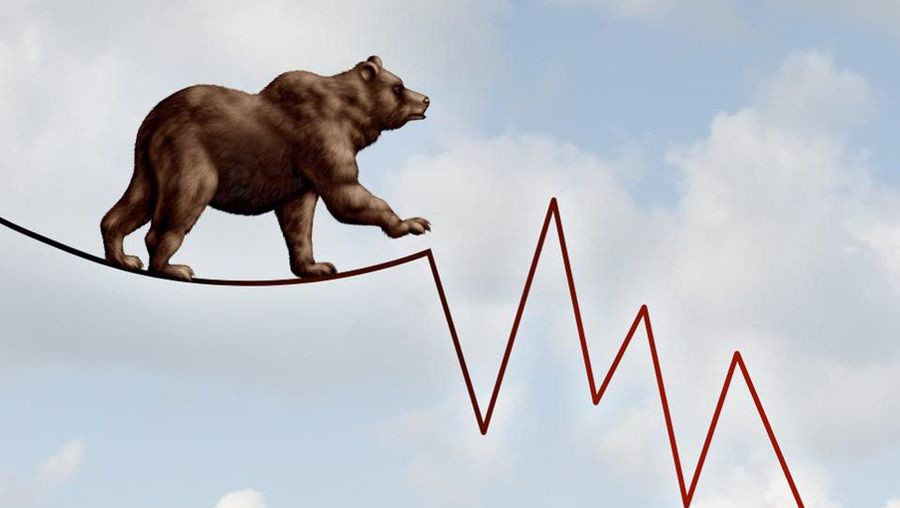
How To Survive In a Bear Market
Are you in a bear market right now? Do you feel you’re about to enter one? Either way, you must know how to survive a bear market.
You can identify a bear market by looking at prices, or more specifically, how much they have dropped. If a particular market falls 20% or more in price, you’ve entered a bear market.

How long does a bear market last? Depending on the nature of the market, it could be several weeks, months, or even years. Therefore, it’s important to know what to do before a bear market occurs.
Give yourself the best chance of survival—find out what steps investors take before and during bear markets.

What To Do Before a Bear Market
If a bear market appears to be imminent, your best defense is to identify your most vulnerable assets. Calculate the risk level of each and try to keep your portfolio balanced. No doubt you will be tempted to sell off as prices drop. However, you risk losing out on a higher return later on. Here are some strategies that bear traders have used prior to a bear market.

Downturns Don’t Last Forever
Ever heard the expression “tough times don’t last, but tough people do?” Well, it has significance in the investor’s world too. Don’t rush to sell your assets when you feel a break market approach.
Instead, keep in mind that the market will rebound as it has before. Those who hold out could see a better return when the market turns back upward.

Diversify
If you haven’t already begun to diversify your investment portfolio, take the opportunity to do so before a bear market or recession begins.
Regardless of a bear market approaching, a diversified portfolio helps you limit risks. By spreading out your investments in several sectors, you give yourself a fighting chance during downtime.

Calculate Your Risks
This may sound obvious, but it would be ill-advised to place money that you need to pay off bills or groceries in stock.
Bear markets can destroy your investments. The risk of not having food or a home is not worth the potential reward.

What To Do If You Are In a Bear Market
Once you’ve prepared yourself for it, naturally, you’ll want to know how to survive in a bear market. As said before, staying calm and rational during market slowdowns is crucial. The last thing you want to do is panic. Below are several ways to ride out a bear market.

Don’t Sell In Panic
In a market slowdown or recession, you may feel tempted to sell all your assets in a panic.
It may even seem like the right thing to do. But selling in a panic means you won’t see a return on your investment when the market returns to normal.

Accumulate With Dollar Cost Averaging
One mistake people often make while investing is timing the market. Attempting to sell your assets at the “right” time could cost you, literally. Instead, turn to dollar-cost averaging.
With this strategy, you’re purchasing stock regardless of price in regular intervals. The idea is that you’ll reduce the effect of market volatility on prices and avoid a miscalculated timing decision.

Invest Only What You Can Afford To Lose
As crucial as investing is, being smart about how you invest is even more important. Unless you’re absolutely certain you can afford to take a loss on your investment, you should not do it, especially in the case of a bear market, where you have the potential to lose a lot.

Where Investors Put Their Money
Knowing how to survive a bear market is only one part of the equation. You may want to know how you can profit during a falling market. Well, there are several ways that investors like you can use short strategies to increase values. Let’s take a look at what some investors have done in bear markets.

Sell All
To minimize the effects of a bear market, some investors choose to sell all of their assets. They will then put that money into something more stable, such as short-term government bonds. Obviously, this is an extreme route to take, but it can be effective.
One huge downside to selling off is that you risk not timing it right. Sell off too early, and you might miss out on larger gains in the short and long term; wait too long to sell, and you could put yourself in a hole.

Defensive Strategy
This is a strategy for those who want to maintain their position in the stock market and ride out the bear. Similar to the above, this strategy involved placing your investments into much more stable markets, such as large-cap companies.
Larger companies pose less risk, and their share prices are less affected by falling markets. Outside of large companies, another defensive stock you can invest in are essential companies and services.

Small-Cap Stocks Performance In a Bear Market
Small-cap stock’s performance is surprisingly following bear markets and recessions. Despite showing low performances most of the time, small-caps record some of the highest returns when things bounce back.
One thing to keep in mind about small-caps is that they are a high-risk, high-reward investment. Since these companies tend to be new and small, they carry a much higher risk of going under.
But their size is in your favor. It’s much more likely that a small company can double its size than a large, established one. It really boils down to the way you research and analyze small-cap stock.

Become a Better Investor
Whether it’s learning how to survive in a bear market or hunting for small-cap opportunities, Dear Retail is here to help. Join our community of like-minded investors as you explore and expand your knowledge of the stock market. Gain instant access to detailed reporting and receive recurring updates on the companies that are ready to make a splash in the market.







